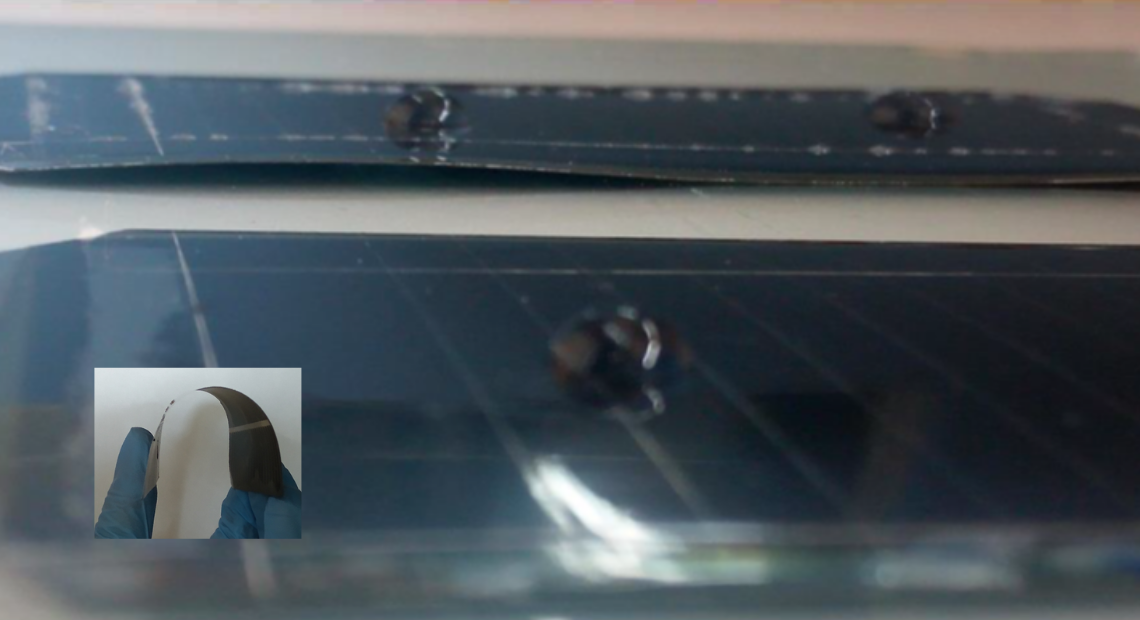(photo credits: Ecolpol Tech hydrophobic coatings showing compatibility with very high flexibility of the CIGS devices.)
For a cost-competitive full market entry, flexible CIGS PV technologies require the availability of innovative encapsulation solutions with both very low costs and excellent barrier properties guaranteeing a long operating time of the devices. Even if there are already existing solutions with acceptable performance levels, costs remain a relevant issue that needs to be solved in order to keep the stringent cost reduction targets established for these technologies. To solve these problems, the DURACIS project has explored new alternative encapsulation and optical glue materials and concepts, compatible with their implementation into already existing industrial CIGS pilot lines and allowing a significant extension of the lifetime while substantially reducing costs. To achieve this goal, transfer of concepts previously developed for organic technologies (with very stringent encapsulation requirements) have been investigated, including innovative self-stratifying organic coatings, the development of ALD-based nanometric barrier layers and the development of new ionomer based encapsulants.
The project has adopted a global strategy including solutions for the main industrial substrate technologies that have been developed for flexible CIGS (polyimide, steel substrates) and has also included the analysis of their transfer into industrial pilot lines available in the consortium. The activities developed in the project have allowed to demonstrate the feasibility of the ALD based nanometric barriers for the effective encapsulation of CIGS devices at both cell and mini-module level, with an encapsulation performance comparable to that achieved with standard glass-glass encapsulation solutions. Cost analysis of the processes shows the potential to achieve a significant reduction of the complete packaging costs when combined with the ionomer-based encapsulant materials developed in the project and state-of-the-art (SOA) front sheets, with estimated costs in the range 15-20 €/m2 that are close to the quantitative cost target that was defined in the project (15 €/m2). Very promising results in terms of compatibility with industrial processes, high optical quality, UV stability and very high flexibility have also been achieved with highly innovative self-stratifying organic coatings, however in this case further development is required for improvement of the barrier properties of these layers.
The project has involved the development of advanced methodologies for the non-destructive monitoring of the encapsulation processes and layers at IREC, including the in-line fast assessment of the thickness of the nanometric barrier layers developed in the project
DURACIS has been coordinated by the Solar Energy Materials & Systems (SEMS) group from IREC and has involved a strong inter-sectoral and interdisciplinary consortium including research groups from ZSW (Germany), IPVF (France), University of Innsbuck (Austria) and relevant companies from the Organic chemistry, Energy and Photovoltaic sectors as Ecopol Tech (Spain), AC&CS (Belgium), Eliosys (Belgium), EDF R&D (France), Sunplugged (Austria) and Lenzing Plastics (Austria).
This project was financed by the “Programa Acciones de Programación Conjunta Internacional” from Ministerio de Economía, Industria/Competitividad-Agencia Estatal de Investigación, within the SOLAR-ERA.NET Joint Calls.




